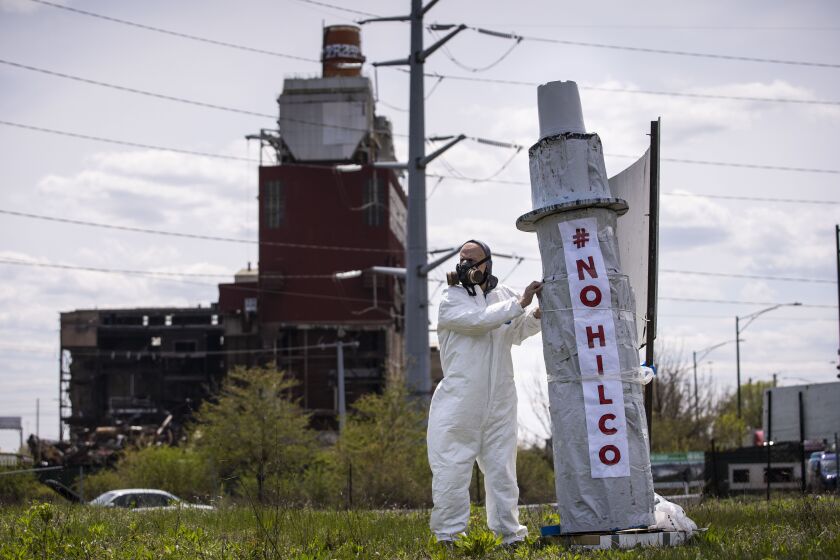The battle for environmental justice — the idea that poorer communities should not bear an unfair share of pollution — stretches back decades, but a Little League field in Hegewisch shows how much remains to be done.
As the Sun-Times’ Brett Chase reported this week, U.S. Environmental Protection Agency officials are replacing soil contaminated by lead and arsenic at the Hegewisch Little League Field, at 127th Street and Carondolet Avenue, with clean dirt. Kids were playing on the decades-old field, now called a “substantial threat to the public health,” as recently as last summer.
Why are neighborhoods with limited resources still battling pollution more than three decades after the environmental justice movement formally was launched? It’s been 24 years since former President Bill Clinton signed an executive order designed to ensure that the environment and health of minority and low-income populations are safeguarded “with the goal of achieving environmental protection for all communities.”
Pollution and COVID-19
In Chicago, part of the problem is that City Hall hasn’t done enough to make sure all city departments work together to prevent environmental degradation and health threats in economically challenged neighborhoods, says Kimberly Wasserman, executive director of the Little Village Environmental Justice Organization.
Little Village has the second-worst air quality in the state, yet the city has approved the construction of a warehouse that will bring trucks spewing airborne particulate matter through the neighborhood. A recent Harvard University study found that high levels of particulate matter are associated with a 15% higher mortality rate among people who contract COVID-19, and Little Village’s Zip code already is among the worst hit by the coronavirus.
“There needs to be a systemic look at the city’s policies across the board,” Wasserman told us on Wednesday. “Other cities are having these conversations.”
Environmentalists and community activists won a victory in 2012 when two notorious coal-burning power plants in Little Village and Pilsen were closed after a long battle. But activists still have their hands full elsewhere.
They are protesting the new MAT Asphalt plant in the McKinley Park neighborhood — right across the street from the classic Southwest Side park.
They are understandably alarmed by the presence of almost 90 acres of former toxic-waste dumps just a short walk from the CHA’s Altgeld Gardens and Trumbull Park. They have been battling petcoke and manganese contamination for years on the Southeast Side.
And they are fighting a plan by General Iron to move a metal shredder from Lincoln Park to the East Side, which already suffers from respiratory health issues.
A report released last month by the Shriver Center on Poverty Law documents how federal policies historically encouraged the placement of federally assisted housing developments in areas of environmental contamination — and also allowed industries that pollute to be built near existing low-income housing.
That would be the very opposite of environmental justice.
More than a pollution threat
Environmental injustice is about more than direct air, water and noise pollution.
Economically challenged communities also tend to be prone to flooding and are vulnerable to heat waves, not unlike the heat wave Chicago is experiencing now, because they often lack tree cover and parks. For a sixth straight day on Wednesday, the Illinois Environmental Protect Agency issued an air quality alert for the city.
But making communities environmentally safer has gotten tougher under President Donald Trump. His administration has reversed at least 100 environmental rules. Limits on carbon dioxide emissions from power plants and vehicles have been weakened, for example, and power plants can more easily emit mercury.
Protecting less advantaged communities is complicated further in Illinois by a law that prohibits the state Environmental Protection Agency from considering the cumulative effect of multiple industry permits, says Jen Walling, executive director of the Illinois Environmental Council. The effect of the prohibition is that a neighborhood might be beset by various types of pollution — from power plants, sewage treatment plants, incinerators and waste sites — that, if looked at individually, do not exceed legal limits. But cumulatively, they can make life miserable.
Illinois should follow the lead of New Jersey, where the state Senate last week approved legislation that requires a more all-encompassing approach to assessing the impact of environmental pollution.
New city adviser on environment
Economic justice can get complicated. At times, communities are actually wary of improvements such as replacing old industrial sites with parks, worried about higher property taxes and rents.
Residents also sometimes are wary that air and water testing could tag their neighborhood as an environmentally unsafe place to live. But air and water pollution travel. Less pollution in one part of town means a little less pollution in every part of town.
On June 11, Mayor Lori Lightfoot named a policy adviser on environmental issues, Angela Tovar, which we welcome. And the Metropolitan Water Reclamation District’s new watershed management ordinance for the first time requires that the disparate impact on different communities be taken into consideration.
But let’s face it.
When kids for decades are allowed to play baseball on a field full of toxic lead and arsenic — and only now is something being done about that — it’s safe to say Chicago’s got a long way to go when it comes to environmental justice.
Send letters to letters@suntimes.com.







